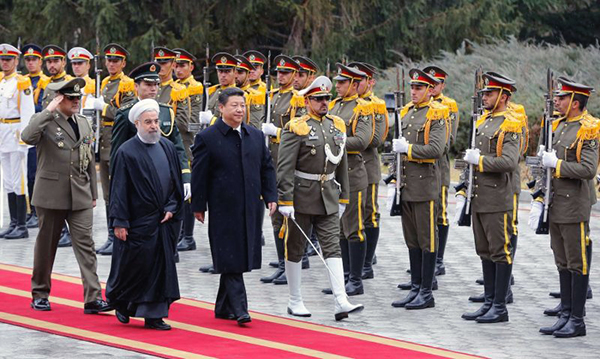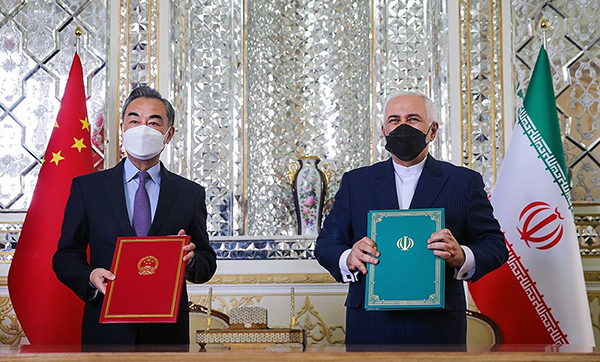The Perfect Hedge – China’s Story
The signing of the Iran–China 25-year Cooperation Programme on 27 March 2021 in Tehran went, to a large degree, under-reported. The fact that the contents of the agreement are classified and the text of the leaked draft agreement from 2020 is very vague, helps significantly for the mass media to underestimate the magnitude of the geopolitical importance of this cooperation. However, a deeper analysis shows that with that step China managed to achieve two extremely important goals: firstly, secure its oil supply and secondly, do that at such price that expensive transport routes, such as the China-Pakistan Economic Corridor (CPEC), become cost-effective even in crisis situations, which eliminates China’s long troubling Achilles Heel – the Malacca Dilemma.
The Importance of Oil
Oil is the blood of war. Without sufficient resources no military campaign can be successful and no advances can be sustainable because oil is needed for practically every machinery used to take over and control the ground. Securing its supply is the most important task facing the leader preparing for large scale operations. In order to plan this, the time-frame of the campaign must be considered, as well as the expected consumption. If, at any point, the supply is halted, then everything stops – there is no use of tank divisions if they cannot get to the front and an aircraft carrier becomes a sitting duck if the supporting fleet of marine and air vessels are not around.
Over the last few years China has openly and repeatedly declared its intentions to implement a long-term strategy to change the world order in a way, which is incompatible with peace. The Chinese Communist Party’s (CCP) leadership has long viewed their ideological system, the socialism with Chinese characteristics, as genuinely conflicting with the systems of the rest of the world. This divide could not become anymore clearer when the leader of the country, General Secretary Xi Jinping announced in 2013 from the highest forum, in a speech in front of the CCP Central Committee, that China needed to prepare for a period of conflict between these two social systems, including in their military domains.
The procurement for such conflict cannot remain unresolved. China sources its oil from the open market in peacetime and it is transported with tankers. Normal cost is between $2 and $3 per barrel to have it shipped to Chinese ports. During severe crises, however, markets react to the implied insecurity and the price can increase dramatically, often reaching $10-14 levels. The problem is that such levels are not sustainable in the long run as they can impact their economy adversely.
The cost of oil transport is not the only problem for China in an eventual military conflict – the ability to actually reach their ports is a clear and present danger. Currently, all the routes for the energy imports for China pass through the Malacca Strait – a long and narrow stretch between Indonesia and Malaysia. China’s implied risk in this situation is that, in case of international disagreement, this strait could easily be closed, a crisis event known as the “Malacca Dilemma”. This scenario would put China’s economy and population in a serious situation without many options and they would be prone to influence. Bypassing would require rerouting through Java Sea or Timor Sea, which would increase delivery times prohibitively and most importantly – risks for tankers capture and cargo loss.
When China invested in CPEC and influence in Pakistan they took care of the Malacca problem theoretically. Practically, the cost of transporting oil via CPEC remained very high, largely due to the difficulties arising from the engineering complexity needed for the terrain conditions – the pipe has to pass the highest mountains in the world and withstand formidable climate all year round. Because of this, CPEC could be viewed as possible Plan B and unsustainable solution. Until somebody could step in and pay the bill.


Pushing Iran to the Wall
Understanding the situation of Iran is very important to show how it slid into the Chinese embrace. Since their inception, the goals of sanctions have been to change Iran’s behavior with the idea that a severely hit and under-performing economy would limit the funds for the pursuit of core strategic objectives, which include, among others, support for regional armed factions and the development of ballistic missiles carrying nuclear warheads. Unfortunately for the US, the sanctions did not bring the desired results and, in late 2018, the Trump Administration decided to apply “maximum pressure” via a revised and stricter JCPOA (Joint Comprehensive Plan of Action). The severely limited ability to sell oil and the isolation from the international financial system sent the Iranian economy into a downward spiral, to which Iran responded by decreasing its commitments to previous sanctions and conducting special operations in the Gulf and Iraq.
China’s behavior then became very interesting. Their oil purchases from Iran at that time were at a 4-year peak averaging nearly $2 bn per month for the 10 months before the stricter sanctions. Interestingly, a downward trend started immediately after that, excluding only the upcoming peak demand months of February and March. The trend was so strong that it brought the monthly purchases to below a quarter of what they used to be – $0.2 to 0.5 bn and it continued ever since. The data comes from the National Bureau of Statistics of China and Refinitiv.
The counter argument is that China compensated with unofficial purchases due to the US sanctions. It is true that such purchases were taking place and that the practice of the Iranian tankers to switch off their transponders to avoid detection has been a hot topic in news covering the oil industry. According to Refinitiv, quoted also by Reuters, such purchases were negligible (total amounts not exceeding $0.5 bn) until November 2020. After that the portion of unofficial purchases – either through proxies, such as Oman, Malaysia and UAE, or through the “ghost” fleet of Iranian tankers – started increasing dramatically, reaching nearly 3.5 million tonnes in February 2021.
It is clear that China chose its policy very carefully. By letting Iran suffer for 2 years through limiting their own purchases from them, they increased the instability in the already aching economy of the Islamic republic. It was the perfectly created moment to present an opportunity to finalize the deal for the partnership agreement between both sides. Such strategy involved no risk for the Chinese economy, as Iran’s crude represented just 9% from all oil imports during the peak in 2014, as per data by Statista, so after the intervention the share must have dropped below 3%.
In this dire situation, China offered to help by purchasing their oil at heavy discounts, to fund their infrastructure projects (in other words, to immensely increase economic and political pressure as this is what happened in Pakistan, Sri Lanka and with all their partners) and to help in the IT sphere. Considering the implementation of the social grading system and the mass surveillance in China, it is safe to assume that they offered Iran the way to exercise tighter control over its population as a way to counter Western influence. Even though specifics were not mentioned, such cooperation would be impossible without the use of hardware by Huawei and similar telecom/networking companies with proven links to the Peoples Liberation Army (PLA).
The Perfect Deal
Hedging in finance is the practice of reducing risks of adverse price movements of assets. It is somewhat similar to insurance – there are hundreds of ways of doing it, but the bottom line is that the interested party pays a premium to another party willing to take a specified risk. The situation with the China–Iran relationship is particularly interesting, because China has the incentive to secure CPEC both physically and financially, as well as to find a way to eliminate their biggest oil supply chain risk. Additional objectives include the extension of the multi-billion projects along the Belt and Road Initiative (BRI) and use that synergy to create dependency of an autocratic government, further helping them to tighten the grip over its population and give the PLA direct access to practically all networks in the country. In exchange for this, that government will give them a preferable price to their main export commodity.
In order to understand the magnitude of the discount, we need to consider the worst possible scenarios and calculate the profitability there. Even in scenarios using transportation cost equal to those in the highest recorded peaks, China would get the oil at their ports 8-12% cheaper than what it would cost in peacetime before signing the agreement. Additionally, a 20% discount, at the current cost structure for extraction for Iran, would require that Iran produces 35% more oil in order to end up with the same net income. Anything below that would essentially drain the budget in the mid to long term.
The outlook for the Iranian government is rather grim. The increased oil purchases were the sweetener of the deal and considering the share of the Iranian crude in the Chinese imports, they are far from vital. Which means that the leadership in Beijing has very little motivation to keep the purchases at these high levels. Instead, it needs to keep on having Tehran pressed against the wall and dependent on this lifeline. This also means that the sanctions implemented by the White House might have negative impact on Iran, but they definitely strengthen China’s position in the region. Additionally, those sanctions were done to avoid a situation where Iran becomes a military nuclear power, but if in the future China considers a scenario, where it is good for them to have WMDs located there, they could easily supply them. Against another level of dependency, of course.
The trade is nothing short of genius. China has made Iran pay for its own export in such way that it would be profitable to go through the most expensive route in the most adverse time for international trade (considering a military conflict, which closes the Malacca Strait). In the civilian world this is similar to a client receiving the monthly premium payments from the insurance company for his car insurance policy, rather than making them. It is an absurd situation, which gives all the benefits to one of the sides only.
The China-Iran partnership scenario is not a product of coincidental political and trade decisions over the years, but rather a part of a carefully crafted policy. The strategists of the West are so far failing miserably against those in Beijing and need to fundamentally reconsider their relationships as time is running out. Partnerships, such as the Quad, have to be the focus of the foreign policy of Washington and the European Union, because the CCP is acting on its plan and the risks, which seemed almost like a fiction a decade ago, are a present day reality hanging like the sword of Damocles over the democratic world.













